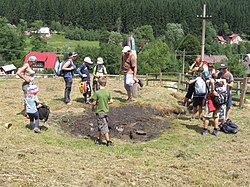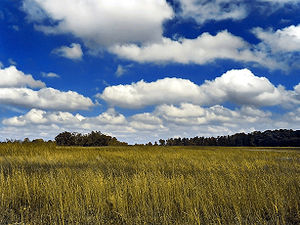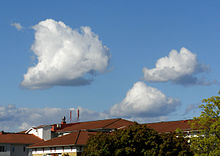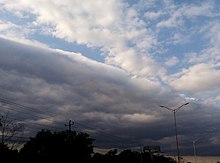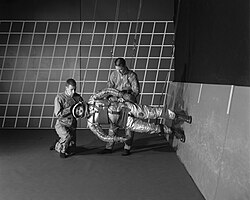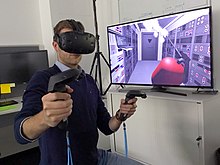From Wikipedia, the free encyclopedia
A
test subject being suited up for studies on the Reduced Gravity Walking
Simulator. This position meant that a person's legs experienced only
one sixth of their weight, which was the equivalent of being on the
lunar surface. The purpose of this simulator was to study the subject
while walking, jumping or running. (1963)
Astronaut training describes the complex process of preparing astronauts in regions around the world for their space missions before, during and after the flight, which includes medical tests, physical training, extra-vehicular activity (EVA) training, procedure training, rehabilitation process, as well as training on experiments they will accomplish during their stay in space.
Virtual and physical training facilities have been integrated to
familiarize astronauts with the conditions they will encounter during
all phases of flight and prepare astronauts for a microgravity
environment. Special considerations must be made during training to ensure a safe and successful mission, which is why the Apollo astronauts received training for geology field work on the Lunar surface and why research is being conducted on best practices for future extended missions, such as the trip to Mars.
Purpose of training
Training flow
The selection and training of astronauts are integrated processes to ensure the crew members are qualified for space missions.
The training is categorized into five objectives to train the
astronauts on the general and specific aspects: basic training, advanced
training, mission-specific training, onboard training, and proficiency
maintenance training.
The trainees must learn medicine, language, robotics and piloting,
space system engineering, the organization of space systems, and the
acronyms in aerospace engineering
during the basic training. While 60% to 80% of the astronauts will
experience space motion sickness, including pallor, cold sweating,
vomiting, and anorexia,
the astronaut candidates are expected to overcome the sickness. During
the advanced training and the mission specific training, astronauts will
learn about the operation of specific systems and skills required
associated with their assigned positions in a space mission. The mission
specific training typically requires 18 months to complete for Space Shuttle and International Space Station crews.
It is important to ensure the astronauts’ well-being, physical and
mental health prior, during, and after the mission period. Proficiency
maintenance aims to help the crew members to maintain a minimum level of
performance, including topics such as extravehicular activity,
robotics, language, diving, and flight training.
Launch and landing
The effects of launching and landing has various effects on astronauts, with the most significant effects that occur being space motion sickness, orthostatic intolerance, and cardiovascular events.
Space motion sickness is an event that can occur within minutes
of being in changing gravity environments (i.e. from 1g on Earth prior
to launch to more than 1g during launch, and then from microgravity in
space to hypergravity during re-entry and again to 1g after landing).
The symptoms range from drowsiness and headaches, to nausea and
vomiting. There are three general categories of space motion sickness:
- Mild: One to several transient symptoms, no operational impact
- Moderate: Several symptoms of persistent nature, minimal operational impact
- Severe: Several symptoms of persistent nature, significant impact on performance
About three-fourths of astronauts experience
space motion sickness, with effects rarely exceeding two days. There is a
risk for post-flight motion sickness, however this is only significant
following long-duration space missions.
Post-flight, following exposure to microgravity, the vestibular system, located in the inner ear is disrupted because of the microgravity-induced unresponsiveness of the otoliths
which are small calcareous concretions that sense body postures and are
responsible for ensuring proper balance. In most cases, this leads to
some postflight postural illusions.
Cardiovascular events represent important factors during the three phases of a space mission. They can be divided in:
- Pre-existing cardiovascular diseases: these are typically selected-out during astronaut selection, but if they are present in an astronaut they can worsen over the course of the spaceflight.
- Cardiovascular events and changes occurring during spaceflight:
these are due to body fluids shift and redistribution, heart rhythm
disturbances and decrease in maximal exercise capacity in the micro
gravity environment. These effects can potentially lead the crew to be
severely incapacitated upon return to a gravitational environment and
thus unable to egress a spacecraft without assistance.
- Orthostatic intolerance leading to syncope during post-flight stand test.
On-orbit operations
Astronauts are trained in preparation for the conditions of launch as
well as the harsh environment of space. This training aims to prepare
the crew for events falling under two broad categories: events relating
to operation of the spacecraft (internal events), and events relating to
the space environment (external events)
An
internal view of ESA's Columbus module training mockup, located at the
European Astronaut Centre in Cologne, Germany. Astronauts must
familiarize themselves with all the spacecraft components during their
training.
During training, astronauts are familiarized with the engineering systems of the spacecraft including spacecraft propulsion, spacecraft thermal control, and life support systems. In addition to this, astronauts receive training in orbital mechanics, scientific experimentation, earth observation, and astronomy. This training is particularly important for missions when an astronaut will encounter multiple systems (for example on the International Space Station
(ISS)). Training is performed in order to prepare astronauts for events
that may pose a hazard to their health, the health of the crew, or the
successful completion of the mission. These types of events may be:
failure of a critical life support system, capsule depressurization,
fire, and other life-threatening events. In addition to the need to
train for hazardous events, astronauts will also need to train to ensure
the successful completion of their mission. This could be in the form
of training for EVA, scientific experimentation, or spacecraft piloting.
External events
External
events refers more broadly to the ability to live and work in the
extreme environment of space. This includes adaptation to microgravity
(or weightlessness), isolation, confinement, and radiation. The difficulty associated with living and working in microgravity include spatial disorientation, motion sickness, and vertigo.
During long-duration missions, astronauts will often experience
isolation and confinement. This has been known to limit performance of
astronaut crews and hence training aims to prepare astronauts for such
challenges.
The long-term effects of radiation on crews is still largely unknown.
However, it is theorized that astronauts on a trip to Mars will likely
receive more than 1000x the radiation dosage of a typical person on
earth. As such, present and future training must incorporate systems and processes for protecting astronauts against radiation.
Science experiments
Scientific
experimentation has historically been an important element of human
spaceflight, and is the primary focus of the International Space
Station. Training on how to successfully carry out these experiments is
an important part of astronaut training, as it maximizes the scientific
return of the mission. Once on-orbit, communication between astronauts
and scientists on the ground can be limited, and time is strictly
apportioned between different mission activities. It is vital that
astronauts are familiar with their assigned experiments in order to
complete them in a timely manner, with as little intervention from the
ground as possible.
For missions to the ISS, each astronaut is required to become
proficient at one hundred or more experiments. During training, the
scientists responsible for the experiments do not have direct contact
with the astronauts who will be carrying them out. Instead, scientists
instruct trainers who in turn prepare the astronauts for carrying out
the experiment. Much of this training is done at the European Astronaut
Center.
For human experiments, the scientists describe their experiments
to the astronauts who then choose whether to participate on board the
ISS. For these experiments, the astronauts will be tested before,
during, and after the mission to establish a baseline and determine when
the astronaut returned to the baseline.
A researcher using VR headset to investigate ideas for controlling rovers on a planet.
Purpose of virtual reality training
Virtual
reality training for astronauts intends to give the astronauts
candidates an immersive training experience. Virtual reality has been
explored as a technology to artificially expose astronauts to space
conditions and procedures prior to going into space. Using virtual
reality, astronauts can be trained and evaluated on performing an EVA
(extravehicular activity) with all the necessary equipment and
environmental features simulated. This modern technology also allows the
scenario to be changed on the go, such as to test emergency protocols.
The VR training systems can reduce the effects of the space motion
sickness through a process of habituation. Preflight VR training can be a
countermeasure for space motion sickness and disorientation due to the
weightlessness of the microgravity environment.
When the goal is to act as a practice tool, virtual reality is commonly
explored in conjunction with robotics and additional hardware to
increase the effect of immersion or the engagement of the trainee.
Training by region
United States
At
NASA, following the selection phase, the so-called "AsCans" (Astronaut
candidates) have to undergo up to two years of training/indoctrination
period to become fully qualified astronauts.
Initially, all AsCans must go through basic training to learn both
technical and soft skills. There are 16 different technical courses in:
Astronauts train in the Neutral Buoyancy Facility at the Johnson Space Center in Houston, Texas
The
Crew of STS-135 practices rendezvous and docking with the ISS in the
Systems Engineering Simulator at the Johnson Space Center on June 28,
2011 in Houston, Texas.
AsCans initially go through Basic Training, where they are trained on Soyuz,
and ISS systems, flight safety and operations, as well as land or water
survival. Pilot AsCans will receive training on NASA's T-38 Trainer Jet.
Furthermore, because modern space exploration is done by a consortium
of different countries and is a very publicly visible area, astronauts
received professional and cultural training, as well as language courses
(specifically in Russian).
Following completion of Basic Training candidates proceed to
NASA's Advanced Training. AsCans are trained on life-sized models to get
a feel of what they will be doing in space. This was done both through
the use of the Shuttle Training Aircraft
while it was still operational and is done through simulation mock-ups.
The shuttle training aircraft was exclusively used by the commander and
pilot astronauts for landing practices until the retirement of the
Shuttle, while advanced simulation system facilities are used by all the
candidates to learn how to work and successfully fulfill their tasks in
the space environment. Simulators and EVA training facilities help
candidates to best prepare their different mission operations. In
particular, vacuum chambers, parabolic flights, and neutral buoyancy facilities (NBF) allow candidates to get acclimated to the micro gravity environment, particularly for EVA. Virtual reality is also becoming increasingly used as a tool to immerse AsCans into the space environment.
The final phase is the Intensive Training. It starts at about
three months prior to launch, preparing candidates for their assigned
mission. Flight-specific integrated simulations are designed to provide a
dynamic testing ground for mission rules and flight procedures. The
final Intensive Training joint crew/flight controller training is
carried out in parallel with mission planning. This phase is
where candidates will undergo mission specific operational training, as
well as experience with their assigned experiments. Crew medical officer
training is also included to effectively intervene with proactive and
reactive actions in case of medical issues.
Notable training facilities
It can take up to two years for an AsCan to become formally qualified
as an astronaut. Usually, the training process are completed with
various training facilities available in NASA: Space training facilities try to replicate or simulate the experience of spaceflight in a spacecraft as closely and realistically as possible. This includes full-size cockpit replicas mounted on hydraulic rams and controlled by state of the art computer technology; elaborate watertanks for simulation of weightlessness; and devices used by scientists to study the physics and environment of outer space.
- Space Vehicle Mock-up Facility (SVMF): located in the Johnson
Space Center in Houston, TX. The SVMF consists of life-size models of
vehicles of the ISS, the Orion, and different other commercial programs.
The purpose of SVMF is to provide a unique simulated experience for
astronauts to get familiar with their tasks in space vehicles. Potential
training projects include preparation of emergency, on-orbit
intra-vehicular maintenance, and airlock operations. The facility also
provides experiences for astronauts in real-time communications with the
ground team for mission support.
- KC-135 Stratotanker: the KC-135 is an air-refueling plane designed
by Boeing. Known as the “Weightless Wonder” or the “Vomit Comet”, this
plane is the most famous of its kind,
which has served to simulate reduced or microgravity environments for
NASA astronauts since 1994. The “roller coaster” maneuvers that the
plane is capable of doing provide people as well as equipment onboard
about 20–25 seconds of weightlessness.
- The Precision Air-Bearing Floor (PABF): located in the Johnson Space
Center in Houston, TX. Because of the microgravity environment in
space, the resulting lack of friction posts difficulties for astronauts
to move and stop large objects. The PABF is a “flat floor” that uses
compressed air to suspend typical hardwares or mock-ups that astronauts
may encounter in space above the ground. It is used to simulate
low-friction environments for astronauts to learn to move large objects.
- The Neutral Buoyancy Lab: (NBL): located in the Johnson Space Center
in Houston, TX. Through a combination of weighting and floating
effects, the NBL creates a balance between the tendencies to sink and to
float, and therefore simulating the experience of weightlessness. In
the NBL, several full-size models of the space vehicles are present in a
large “water tank”. Unlike the SVMF, the NBL helps astronauts train on
projects such as maintenance, but outside of the space vehicle.
Europe
Astronaut training in Europe is carried out by the European Astronaut Centre (EAC), headquartered in Cologne, Germany. European training has three phases: Basic training, Advanced training, and Increment Specific Training.
Soyuz
capsule simulator located at the EAC in Cologne, Germany. ESA
astronauts will simulate operations in the capsule at the EAC.
For all ESA selected astronauts, Basic Training begins at the EAC
headquarters. This section of the training cycle has four separate
training blocks that last 16 months. Astronauts will receive an
orientation on the major spacefaring nations, their space agencies, and
all major crewed and uncrewed space programs. Training in this phase
also looks into applicable laws and policies of the space sector.
Technical (including engineering, astrodynamics, propulsion, orbital mechanics, etc.) and scientific (including human physiology, biology,
earth observation, and astronomy) basics are introduced, to ensure that
all new astronauts have the required base level of knowledge. Training
is done on ISS operations and facilities, including an introduction to
all major operating systems on board the ISS that are required for its
functionality as a crewed space research laboratory. This phase also
covers in-depth systems operations for all spacecraft that service the
ISS (e.g. Soyuz, Progress, Automatic Transfer Vehicle (ATV), and the H-II Transfer Vehicle (HTV)), as well as ground control and launch facility training. This training phase also focuses on skills such as robotic operations, rendezvous and docking, Russian language courses, human behavior and performance, and finally a PADI
open water scuba diving course. This scuba course provides basic EVA
training at ESA's NBF before moving onto the larger NASA training
facility at the Lyndon B. Johnson Space Center.
Advanced Training includes a much more in-depth look into the
ISS, including learning how to service and operate all systems. Enhanced
science training is also implemented at this time to ensure all
astronauts can perform science experiments on board the ISS. This phase
takes around one year to complete and training is completed across the
ISS partner network, no longer only at the EAC. It is only upon
completion of this phase that astronauts are assignment to a
spaceflight.
Increment-Specific Training starts only after an astronaut has
been assigned to a flight. This phase lasts 18 months and prepares them
for their role on their assigned mission. During this phase crew members
as well as backup crews will train together. The crew tasks on the ISS
are individually tailored, with consideration to the astronaut's
particular experience and professional background. There are three
different user levels for all on-board equipment (i.e. user level,
operator level, and specialist level). A crew member can be a specialist
on systems while also only being an operator or user on others, hence
why the training program is individually tailored. Increment Specific
Training also includes training to deal with off-nominal situations.
Astronauts will also learn how to run the experiments that are
specifically scheduled for their assigned missions.
Russia
The grounds of the Gagarin Cosmonauts Training Center
Training for cosmonauts falls into three phases: General Space Training, Group Training, and Crew Training.
General Space Training lasts about two years and consists of classes,
survival training, and a final exam which determines whether a cosmonaut
will be a test or research cosmonaut. The next year is devoted to
Group Training where cosmonauts specialize in the Soyuz or ISS as well
as professional skills. The final phases, the Crew Training phase, lasts
a year and a half and is dedicated to detailed vehicle operations
procedures, ISS training, and the English language.
Training primarily takes place at the Yuri Gagarin Cosmonaut Training Center.
The center facilities have full size mockups of all major Soviet and
Russian spacecraft including the ISS. As with the ISS astronauts,
cosmonauts train in the US, Germany, Japan, and Canada for specific training in the various ISS modules.
Japan
The
Japanese human spaceflight program has historically focused on training
astronauts for Space Shuttle missions. As such, training previously took
place at NASA's Lyndon B. Johnson Space Center, and followed that of
NASA astronauts and other international participants in the Space
Shuttle program.
H-II rocket outside the Tsukuba Space Center where training of JAXA astronauts takes place
Since the development of domestic training facilities at the Tsukuba Space Center,
training has increasingly taken place in Japan. With Japan's
participation in the ISS, the training of Japanese astronauts follows a
similar structure to that of other ISS partners. Astronauts carry out
1.5 years of Basic Training mainly at Tsukuba, followed by 1.5–2 years
of Advanced Training at Tsukuba and ISS partner sites. Training for any
international ISS astronauts involving the Kibo module will also be carried out at Tsukuba Space Center.
Advanced Training is followed by Increment-Specific Training,
which, along with any Kibo training, will be carried out at Tsukuba. EVA
training for Kibo takes place in the Weightless Environment Test System
(WETS). WETS is a Neutral Buoyancy Facility featuring a full-scale
mock-up of the Kibo module on the ISS.
The Tsukuba Space Center also includes medical facilities for assessing
suitability of candidates, an isolation chamber for simulating some of
the mental and emotional stressors of long duration spaceflight, and a
hypobaric chamber for training in hull breach or Life Support System
failure scenarios resulting in a reduction or loss of air pressure.
China
Although official detail of the selection process for the Shenzhou program is not available, what is known is that candidates are chosen by the Chinese National Space Administration
from the Chinese air force and must be between 25 and 30 years of age,
with a minimum of 800 hours flying time, and a degree-level education.
Candidates must be between 160 cm and 172 cm in height, and between
50 kg and 70 kg in weight.
For China's Shenzhou astronauts, training begins with a year-long
program of education in the basics of spaceflight. During this period,
candidates are also introduced to human physiology and psychology. The
second phase of training, lasting nearly 3 years involves extensive
training in piloting the Shenzhou vehicle
in nominal and emergency modes. The third and final stage of training
is mission specific training, and lasts approximately 10 months. During
this phase of training, astronauts are trained in the high fidelity
Shenzhou trainer, as well as the Neutral Buoyancy Facility located at
the Astronaut Center of China (ACC), in Beijing.
As well as time spent in the Neutral Buoyancy Facility (NBF), training
for EVA takes place in a high vacuum, low temperature chamber that
simulates the environmental conditions of space. At all stages of
training, astronauts undergo physical conditioning, including time in a
human centrifuge located at the ACC, and a program of micro gravity
flights, carried out in Russia.
India
The Indian
human space flight program still awaits a formal go ahead. Once cleared
the mission is expected to take two Indians in a Soyuz-type orbital
vehicle into low Earth orbit. The training for these astronauts should be based on the lessons learned from training India's only Cosmonaut Wing Commander Rakesh Sharma (See Salyut-7 1984)
and through India's international co-operation with NASA and Roscosmos.
This would allow India to gain insights from their rich experiences in
human spaceflight. There also lies a possibility that India may go
proceed through its human spaceflight program individually,
necessitating the Indian Space Research Organisation (ISRO)
to develop its own training program. For astronaut training, India is
deciding a place which is at a distance of 8 to 10 km from Kempegowda
international airport. This land is under the ownership of ISRO.
Astronaut training and biomedical engineering centers will be built on
it. Though India's first man mission training will take place in USA or
in Russia, this place can be used for future training. Moreover, center
will have chambers for radiation regulation, thermal cycling and
centrifugal for the acceleration training.
Future training
Suborbital astronaut training
Ecuadorian Civilian Space Agency (EXA)
While the first generation of non-government spaceflight astronauts
will likely perform suborbital trajectories, currently companies like Virgin Galactic and Xcor Aerospace
are developing proprietary suborbital astronaut training programs.
However, the first official Suborbital Astronaut Training program was a
joint effort between two government agencies. The Ecuadorian Air Force
and the Gagarin Cosmonaut Training Center
developed the ASA/T (Advanced Suborbital Astronaut Training) program
which lasted up to 16 months between 2005 to 2007 and focused on command
and research duties during short missions with suborbital trajectories
up to 180 kilometers. This program had one Ecuadorian citizen graduate
in 2007, the Ecuadorian Space Agency made a call
for a new class of ASA/T training candidates, accordingly to the EXA,
they will focus on renting commercial suborbital vehicles in order to
perform crewed space research

Human
centrifuge at DLR in Cologne, Germany used for human physiological
tests. The high accelerations experienced during suborbital flights may
necessitate testing or even training on human centrifuges to determine
if participants are fit for space flight
Looking ahead, the emergence of commercial space tourism will
necessitate new standards for flight participants that currently do not
exist. These standards will be to ensure that medical screenings are
done properly in order to ensure safe and successful flights. This
process will differ from that for space agency astronauts because the
goal is not to fly the best individual, but to ensure a safe flight for
the passengers. The main considerations for this type of travel will be:
- What type and extent of training is sufficient?
- Who will qualify space tourists as fit for travel?
- How will new regulations comply with existing medical boards?
- What selection-out criteria need to be employed to reduce dangers to space tourists?
Medical regulations for commercial space flight might mitigate
commercial space company risk by selecting only those capable of passing
standard medical criteria, as opposed to allowing anyone who can
purchase a ticket to fly. The first generation of commercial space
flight will likely be suborbital trajectories
which invoke significant acceleration changes, causing cardiovascular
and pulmonary issues. Because of this any future medical criteria for
commercial spaceflight participants needs to focus specifically on the
detrimental effects of rapidly changing gravitational levels, and which
individuals will be capable of tolerating this.
A fundamentals of scientist-astronaut formative program along with additional Bioastronautics, Extravehicular activity, Space Flight Operations, Flight Test Engineering and Upper-Atmospheric Research courses have been conducted by Project PoSSUM scientist-astronaut candidates since 2015.
As of January 2021, the program has attracted members from 46 different
countries and published research on mesospheric dynamics, human
performance in space suits, microgravity research in various fields, and
post-landing environments. The programs are run by the International
Institute of Astronautical Sciences that has also partnered with
Embry-Riddle Aeronautical University, Final Frontier Design Spacesuits,
Survival Systems USA, National Research Council of Canada, Canadian
Space Agency and the National Association of Underwater Instructors.
Current research on fitness training and strategies for
commercial astronauts conducted by Astrowright Spaceflight Consulting,
the first commercial firm to offer dedicated fitness training for space tourists, suggests that conventional fitness training is inadequate to support safe movement in microgravity, and that training utilizing reduced points of stability should be emphasized.
Long-duration missions to the Moon or Mars
Astronaut during virtual reality training
Astronauts for long term missions–such as those to the Moon or Mars–need
to carry out multiple tasks and duties, because on such missions the
astronauts will need to function largely autonomously, and will need to
be proficient in many different areas. For these types of missions, the
training to prepare astronauts will likely include training as doctors, scientists, engineers, technicians, pilots, and geologists. In addition there will be a focus on the psychological aspects of long-duration missions where crew is largely isolated.
Currently a six-month mission to the ISS requires up to five
years of astronaut training. This level of training is to be expected
and likely to be expanded upon for future space exploration missions. It
may also include in-flight training aspects. It may be possible that
the ISS will be used as a long-duration astronaut training facility in
the future.
A powerful tool for astronaut training will be the continuing use
of analog environments, including NASA Extreme Environment Mission
Operations (NOAA NEEMO), NASA's Desert Research and Technology Studies (Desert RATS), Envihab (planned), Flight Analog Research Unit, Haughton-Mars Project (HMP), or even the ISS (in-flight). In fact, at NEEMO a total of 15 mission astronauts (known as aquanauts) have been trained for future missions to asteroids.
The use of virtual reality will also continue to be used as a means of
training astronauts in a cost-effective manner, particularly for
operations such as extra-vehicular activity (EVA).
These missions are not completely independent without the presence of robots. This opens up a new avenue towards Human-Robot Interaction
which has to be thoroughly understood and practised to develop a
harmonious relationship between astronauts and robots. These robots
would aid the astronauts from being their personal assistants to next
generation of extreme environment explorers. Currently there is a robot
on the ISS aiding the astronauts in their mammoth tasks with a human
touch. Intercultural and human robot interaction training is the need of
the hour for long duration missions.
Training also has to be evolved for future Moon landings to a human mission to Mars.
Factors like crew dynamics, crew size, and crew activities play a
crucial role as these missions would last from one year to Moon to three
years on Mars. The training required for such missions has to be
versatile and easy to learn, adapt, and improvise.
A journey to Mars will require astronauts to remain in the crew capsule for nine months.
The monotony and isolation of the journey present new psychological
challenges. The long period spent in the crew capsule is comparable to
other forms of solitary confinement, such as in submarines or Antarctic
bases. Being in an isolated and confined environment generates stress,
interpersonal conflict, and other behavioral and mental problems.
However, natural scenery and communication with loved ones has shown to
relax and lessen these effects. A Network of Social Interactions for
Bilateral Life Enhancement (ANSIBLE), which provides natural scenery and
socialization in a virtual reality environment, is being researched as a
solution to behavioral health.
Researchers are looking into how current mental health tools can
be adjusted to help the crew face stressors that will arise in an
isolated, confined environment (ICE) during extended missions.
The International Space Station uses a behavioral conflict management
system known as the Virtual Space Station (VSS) to minimize conflict
between crew members and address psychological challenges.
The program has modules that focus on relationship management, stress
and depression that guide astronaut’s through a virtual therapy session
in space.
Virtual reality astronaut training
History
Virtual
reality technologies first came to a commercial release in the 1990s.
It is not until then did people realize that VR can be used in training
astronauts. The earlier VR gears for astronaut training are dedicated to
enhance the communication between robot arm operators and the astronaut
during Extravehicular Activities (EVA). It brings EVA crew members and
robot arm operators together, in live, even when they are on board a
spacecraft. It is also used to replace some of the oversized models that cannot fit in the Neutral Buoyancy Lab (NBL).
In 1993, astronauts were trained and evaluated on working on the
Hubble Space Telescope through a virtual reality training tool, Research
in Human Factors Aspects of Enhanced Virtual Environments for EVA
Training and Simulation (RAVEN). However, the aim of RAVEN was not to
train astronauts but to evaluate the efficacy of training using virtual
reality versus underwater and other setup.
Through the years of technological development in VR, the
hardware for the VR Lab in NASA has also significantly improved. Both
the material and the resolution of the display are being renovated:
- 1991: Liquid-Crystal Display (LCD) - 320x420
- 1992: Cathode Ray Tube (CRT) - 1280x1024
- 2005: Micro Organic Light-Emitting Diode (micro-OLED) - 800x600
- 2012: LCD - 1280x720
- 2015: OLED - 1920x1080
Virtual reality has also been adopted to a much wider range of fields
in space exploration throughout the history of technology renovation.
The newer applications of VR include but are not limited to:
- Mission planning
- Cooperative and interactive designing
- Engineering problem-solving
- Data modeling
Astronauts
Tom Marshburn, left, and Dave Wolf train for a spacewalk in the
Integrated EVA-RMS Virtual Reality Simulator Facility at Johnson Space
Center
Current virtual reality training
While
the extravehicular activities (EVAs) training facility can simulate the
space conditions, including pressure and lighting, the Micro-g environment cannot be fully reconstructed in the Earth’s 1-G environment. Virtual reality is utilized during EVA training to increase the immersion of the training process. NASA Johnson Space Center has facilities such as the Space Vehicle Mockup Facility (SVMF), Virtual Reality Laboratory (VRL), and Neutral Buoyancy Laboratory (NBL).
The SVMF uses the Partial Gravity Simulator (PGS) and air bearing floor (PABF) to simulate the zero-gravity and the effects of Newton's laws of motion.
Similar training systems originated from the Apollo and Gemini
training. Virtual reality enhances an astronaut’s senses during training
modules like fluid quick disconnect operations, spacewalks, and the
orbiter’s Space Shuttle thermal protection system (TPS) repairs.
NASA Virtual Reality Laboratory utilizes virtual reality to supplement the Simplified Aid For EVA Rescue
(SAFER) as simplified aid. The VR training offers a graphical
3-dimensional simulation of the International Space Station (ISS) with a
headset, haptic feedback gloves, and motion tracker. In 2018, two Expedition 55 astronauts Richard R. Arnold and Andrew J. Feustel, received virtual reality training and performed the 210th spacewalk.
The Virtual Reality Laboratory offers astronauts an immersive VR
experience for spacewalks before launching into space. The training
process combines a graphical rendering program that replicates the ISS
and a device called the Charlotte Robot that allows astronauts to
visually explore their surroundings while interacting with an object.
The Charlotte robot is a simple device with a metal arm attached to the
side that allows a user to interact with the device. The user wears
haptic feedback gloves with force sensors that send signals to a central
computer.
In response, the central computer maneuvers the device using a web of
cables and calculates how it would act in space through physics.
While objects are weightless in space, an astronaut has to be familiar
with an object's forces of inertia and understand how the object will
respond to simple motions to avoid losing it in space.
Training can be completed individually or with a partner. This allows
astronauts to learn how to interact with mass and moments of inertia in a
microgravity environment.
The Neutral Buoyancy Laboratory
(NBL) has advantages in simulating a zero-gravity environment and
reproducing the sensation of floating in space. The training method is
achieved by constructing a low gravity environment through Maintaining
the Natural buoyancy in one of the largest pools in the world. The NBL
pool used to practice extravehicular activities or spacewalks is 62
meters (202 feet) long, 31 meters (102 feet) wide, and 12 meters (40
feet) deep, with a capacity of 6.2 million gallons.
Underwater head-mounted display virtual reality headset is used to
provide visual information during the training with a frame rate of 60
fps and screen resolution of 1280 by 1440.
The underwater VR training system has a reduced training cost because
of the accessibility of the VR applications, and astronauts need less
time to complete the assigned practice task.
Despite the NASA training modules, commercial spaceflight
training also uses virtual reality technology to improve their training
systems. Boeing’s virtual reality team develops a training system for Boeing Starliner
to train astronauts to transport between the Earth and the ISS. The VR
training system can simulate high-speed situations and emergency
scenarios, for instance, launching, entering the space, and landing at
an unexpected location.
Advantages of virtual reality training
Visual
reorientation is a phenomenon that happens when the perception of an
object changes because of the changing visual field and cues.
This illusion will alter the astronaut’s perception of the orienting
force of gravity and then lose spatial direction. The astronauts must
develop good spatial awareness and orientation to overcome visual
reorientation. In the traditional disorientation training, for instance,
the Yuri Gagarin Cosmonaut Training Center trains the astronaut by simulating a microgravity environment through a centrifuge. In contrast, VR training requires less gear, training the astronauts more economically.
Virtual reality training utilizes the mix-realistic interaction
devices, such as cockpits in flight simulators can reduce the simulation
sickness and increase user movement.
Compared to traditional training, VR training performs better to
minimize the effects of space motion sickness and spatial
disorientation. Astronauts who received VR training can perform the task
12% faster, with a 53% decrease in nausea symptoms.
While VR is used in astronaut training on the ground, immersive technology also contributes to on-orbit training. VR head-mounted display can help the astronaut maintain physical well-being as part of proficiency maintenance training.
Moreover, VR systems are used to ensure the mental health of the
crewmembers. The simulations of social scenarios can mitigate the stress
and establish the connectedness under the isolated and confined
environment (ICE).
Virtual reality acclimates astronauts to environments in space
such as the International Space Station before leaving earth. While
astronauts can familiarize themselves with the ISS during training in
the NBL, they are only able to see certain sections of the station.
While it prepares astronauts for the tasks they are performing in space,
it does not necessarily give them a full spatial understanding of the
station’s layout. That’s where Virtual Reality plays an important role.
The Virtual Reality Lab uses a system known as the Dynamic Onboard
Ubiquitous Graphics program (DOUG) to model the ISS’s exterior including
decals, fluid lines, and electrical lines, so that the crew can
acclimate to their new environment.
The level of detail goes beyond the exterior of the station. When a
user enters space, they see pure black until their pupil’s dilate and
the sky fills with stars in an occurrence called the ‘blooming effect’.
Disadvantages of virtual reality training
While
virtual reality prepares astronauts for the unfamiliar tasks they will
face in outer space, the training is unable to replicate the
psychological and emotional stress that astronauts face on a daily
basis. This is because virtual tasks do not hold the same repercussions
as the real task and the technology does not produce strong
psychological effects, like claustrophobia, that often occurs in
enclosed environments.
Stimulating a virtual microgravity environment can be costly due
to additional equipment requirements. Unlike commercialized virtual
reality, the equipment that NASA uses cannot be produced at a large
scale because the systems require supplemental technology.
Several VR programs work in combination with the Neutral Buoyancy Lab
or the Charlotte Robot in the Virtual Reality Lab which requires
expensive facilities and does not eliminate the travel component that VR
can minimize.
NASA’s Charlotte robot is restricted by cables that simulate the
microgravity environment and the Virtual Reality Lab only has two
machines in their possession.
This particular training system requires a virtual glovebox system
(GVX) that has been incorporated into training at NASA and the EVA
virtual system at the Astronaut Center of China.
Using sensors embedded in the fabric, the gloves can sense when the
wearer decides to grasp an object or release it, but the technology
needs to be further developed to integrate precise user movements into
virtual programs. These gloves have been reported to be uncomfortable and only capture limited movements.
Full-body motion sensors have also been incorporated into training and
tend to be expensive but necessary in order to have effective tactile
feedback in response to the astronauts movements. While virtual reality
programs have been developed that do not require full-body sensors, the
absence reduces the degree to which a user can interact with the virtual
world.
Future
The
primary focus of future research of virtual reality technologies in
space exploration is to develop a method of simulating a microgravity
environment. Although it has been a goal since the beginning of VR being
used in astronaut training, minor progress has been made. The current
setup uses a bungee rope attached to a person’s feet, a swing attached
to the body, and finally a head mounted VR display.
However, from participants in experiments that use this setup to
simulate reduced gravity environments, they only experience the feel of
moving around in space with the help of VR, but the experience does not
resemble a real zero-gravity environment in outer space. Specifically,
the pressure from the bungee rope and the swing because of the
participants’ own weight creates an unreal and unpleasant feeling.
The current technology may be enough for the general public to
experience what moving around in space is like, but it is still far from
being formally used as an astronaut training tool.
These efforts of simulating micro-gravity serve a similar purpose
of creating an increasingly immersive environment for astronaut
training. In fact, this is a developing trend for the entire VR
industry. The ultimate scene VR experience that we are imagining will
eventually be marked by the elimination between the real and the virtual
world.


